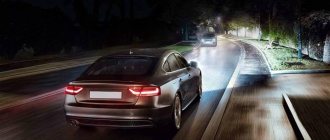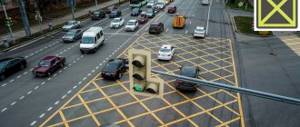Checking the headlights before driving
If the option corresponds to when the headlight does not work at all, that is, it does not shine or does not shine as it should, then there is a clear violation of the “Basic provisions for the approval of vehicles...”. That is, the car should not have been on the road with such defects. This is indicated in clause 3.3 “List of malfunctions and conditions under which the operation of vehicles is prohibited”
External lighting devices and reflectors do not work in the prescribed mode or are dirty.
As a result, this fine will be issued under Article 12.5 of the Code of Administrative Offenses of the Russian Federation, Part 1 “Driving a vehicle in the presence of malfunctions or conditions...”. Now let's figure out what kind of fine can be issued for faulty headlights (dimensions) or even if they are simply dirty.
What to do if one low beam headlight does not light up
If you notice that one headlight in your car has failed, then the problem may lie in the light bulb. The device of this element includes two filament coils, one of them is responsible for the operation of the low beam, and the second for the high beam. One of these threads can easily burn out, which is why the high or low beam will not work.
As you know, if one low beam headlight is not on, the fine can be up to 500 rubles. Of course, you can try to convince the traffic police inspector that you are just heading to the service center to solve the problem, but most likely he will refer to Article 12.20 of the Code of Administrative Offenses, which talks about preventive measures related to violation of the rules for the use of lighting devices on automatic telephone exchanges .
Fine for a non-working headlight (headlights, dimensions)
First, let's quote part 1 of Article 12.5 of the Code of Administrative Offenses of the Russian Federation, it will clarify a lot for us:
Driving a vehicle in the presence of malfunctions or conditions under which, in accordance with the “Basic Provisions ... is prohibited ...”, entails a warning or the imposition of an administrative fine in the amount of 500 rubles
If you continue to study Article 12.5 of the Code of Administrative Offenses of the Russian Federation, you may come across Part 3. It talks about the non-compliance of lighting devices with the prescribed requirements. If the headlights simply do not work, and have not been subjected to unacceptable modifications, then this does not apply to their inconsistencies, which means this part of the article cannot be applied. Here we can also say that Article 27.13 of the Code of Administrative Offenses does not apply to Part 1 of Article 12.5. That is, they cannot detain the car or put it in the impound lot. The driver will be able to continue driving to repair the breakdown. In this case, the driver may be issued a second fine, but only after 24 hours.
Here it is also necessary to pay attention to the possibility of issuing a fine for dirty lighting fixtures. The degree of this contamination is identified in an unclear way and with the help of what instruments. So it will be difficult to argue about this with the traffic police officers in this case. However, this is relevant for the case when at night the car’s rear license plate illumination is dirty, and because of this license plate itself is not visible. In this case, a fine may also be issued for an unreadable license plate that is not visible from 20 meters. More details about this in the article “Fine for dirty numbers”.
How are standard lights used?
When visibility is poor, headlights help distinguish the vehicle to other road users, and in turn allow the driver to distinguish them. This means that a car’s lights are one of its most important parts, and if they fail, they increase the likelihood of accidents. And with all this, headlights can be used not only at night.
Features of operation of fog lights
This mainly applies to fog lights. Today they are installed in almost every car. They will be useful not only in heavy fog, but also in snowfall or heavy rain.
Many people think that the color of fog lights must be yellow. Some people believe that the yellow light travels further through the fog.
And the main difference between these headlights is not the color, but the direction of the light flow. The luminous flux from the headlights is horizontal and flat, and is directed almost parallel to the road, so as not to shine on the curtain of fog.
The fact is that the fog does not reach the ground, since the moisture in the fog condenses if the ground turns out to be much warmer than the air. And with proper adjustment, the light spreads along the road at a distance of ten meters - at low speeds in foggy conditions this is more than enough.
Also, the light from the headlights should spread to the sides so that road markings and the side of the road can be seen.
There are cars equipped with a rear red light - it shines brighter than the side lights or brake lights. In fog, it burns around the clock and allows you to distinguish the owner’s car from a decent distance.
When driving during the day, it is necessary to turn on the low beam headlights - this way the driver will be better seen by road users who are driving towards them; if necessary, they are used together with fog lights.
Fog lights aren't just useful in foggy conditions. They have long been recommended to be turned on when there is a need to drive in the dark, on a narrow road with a lot of turns (especially sudden ones).
On modern cars, the light from the headlights can follow the movement of the steering wheel - this can greatly help when driving along narrow forest roads or cramped yards, when a person or animal may suddenly appear in front of the car. Because of this, in such situations, in addition to the low or high beams, it is worth turning on the fog lights.
When can you travel?
How to avoid a fine for a broken headlight
The best option to avoid a fine is to do the following. Initially, communicate politely with government officials and keep yourself in control. Secondly, the driver must emphasize that he himself is surprised that the headlight does not work. Since the lamp apparently burned out during the trip. When the trip just started, the headlights or headlight were working... Thirdly, Article 12.5 of the Code of Administrative Offenses of the Russian Federation, Part 1 provides for a warning. Fourthly, if you have not been held administratively liable for 6 months, then be sure to say so. As a result, ask the inspector to take all factors into account and issue a warning about the violation, rather than issuing a fine. Here I would like to immediately say that you should not abuse such trust, since the driver himself should be primarily interested in eliminating the breakdown. His health and life depend on it. This is what we will talk about next.
Why the low beam does not work on a Chevrolet Niva: the lamp does not light up
So, if during a lack of power in the low beam, the high beam is on, you can try swapping relays K4 and K5 . K4 is to blame and it needs to be replaced with a new one.
Hello dear portal administration. I have a question, or rather a problem. I have a Chevrolet Niva, 2006, and my low beam headlights periodically stop working. This happens first with one lamp, then with the other, and sometimes both do not work at once. I would like to note that the high beam works properly, regardless of the low beam.
Is it possible to continue driving with a non-working (not lit) headlight (tail light)
The situation with such a malfunction in practice and in law is very interesting. It seems that Article 27.13 of the Code of Administrative Offenses of the Russian Federation “Detention of a Vehicle” does not provide for the detention of a car for such a malfunction. However, there is order 664, on the “Administrative Regulations...”. It contains very interesting recommendations for a police inspector. They are based precisely on the requirements for prohibiting the operation of a vehicle according to the “List of faults and conditions under which the operation of a vehicle is prohibited”
68. If it is revealed that the driver is driving a vehicle with unlit (missing) headlights and tail lights in the dark or in conditions of insufficient visibility, or the driver’s windshield wiper is inoperative during rain or snow <1>, the employee demands that the vehicle stop moving until it is fixed related faults or conditions. At the same time, parking the vehicle should not pose a threat to road safety. <1> Paragraph 2 of clause 2.3.1 of the Traffic Rules. The imposition of an administrative penalty does not relieve the driver from fulfilling the duty for which the administrative penalty was imposed <2>. <2> Part 4 of Article 4.1 of the Code. If the driver fails to comply with the employee’s legal request to stop moving the vehicle until the faults or conditions specified in paragraph one of this paragraph are eliminated, the employee initiates a case for an administrative offense provided for in Part 1 of Article 19.3 of the Code.
That is, the driver may well be “stuck” all night if he doesn’t fix the headlight and it’s dark outside. Indeed, in this case, conditions when rear lights are not needed will arise only during daylight hours. Thus, a malfunction of the headlight can lead to a whole chain of troubles.
Is it possible to pay a fine for a non-working headlight or clearance with a 50 percent discount?
Since 2021, drivers who violate traffic rules, but are ready to repent and pay a fine, have the opportunity to pay this same fine with a 50 percent discount. For the sake of fairness, it should be noted that such a discount can not be obtained for every fine, but only for “non-serious” forms of traffic violations. So Article 12.5 falls under the same option when the fine can still be paid with a discount of 50 percent, that is, half as much. To do this, you must pay the traffic police fine from the time it appears in the database, but no later than 20 days from the date of its commission. More details about this in the article “How to pay a fine with a 2-fold discount.”
Summarizing the topic “Fine for non-working headlight(s)”
If a headlight or headlights on a car do not work, then several conclusions can be drawn at once. First of all, it's simply not safe. Especially in the dark, when only one headlight works. If the second one suddenly burns out, it can lead to an accident at high speed. This means it jeopardizes the health and life of the driver and passengers, if there are any in the car. One can only wonder why Article 27.13 of the Code of Administrative Offenses of the Russian Federation does not provide for the detention of such vehicles in the dark. After all, this is dangerous not only for the driver and passengers of a vehicle with a malfunction, but also for the road users around it. Secondly, if the headlights or headlights do not work, then this simply threatens with administrative liability in the form of a warning or a fine. There is nothing good in this either, it is a waste of nerves, time, money. That is why try to monitor the serviceability of the headlights on your car.
Some motorists forget to turn on their low beams during daylight hours.
If the inspector refers to the list of faults ( clause 3.3 ), the motorist faces a written warning about the violation or a monetary penalty of 500 rubles . There is also a fine for high beams in the city; it must be switched in accordance with traffic rules.
One low beam lamp (headlight) is not lit or has burned out, will a fine be imposed in this case? There are times when one headlight bulb , one fog light bulb, or one daytime running light . If a traffic police inspector stops a person driving a car and charges him with a traffic violation, there are several options for the development of the situation .
Questions and answers on the topic “Fine for non-working headlight(s)”
Question: Can they issue a fine for the fact that 1 headlight on a car does not work? Answer: Yes, they can. This is a warning or a fine of 500 rubles.
Question: Can a car be detained for a parking fine if the headlight is not working? Answer: No, Article 27.13 of the Code of Administrative Offenses of the Russian Federation does not provide for this, but they may force you to repair the headlight right on the spot or prohibit further movement.
Video about a fine for a non-working headlight
For those who do not like to read, we have prepared a video that fully reflects the essence of the article and talks about a possible fine for a non-working headlight.










